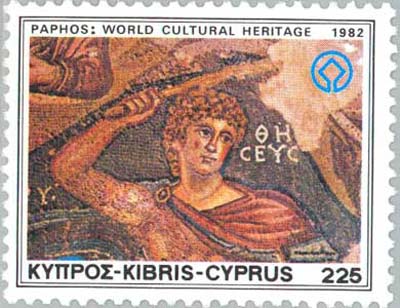
Theseus Mosaic in Paphos, Cyprus
Theseus (Θησέας / Θησευς) was a legendary king of Athens, son of Aegeus (or of Poseidon). Theseus was a founder-hero, like Perseus, Cadmus or Heracles, all of whom battled and overcame foes that were identified with an archaic religious and social order. As Heracles was the Dorian hero, Theseus was the Ionian founding hero, considered by Athenians as their own great reformer. His name comes from the same root as θεσμoς, "thesmos", Greek for institution. In The Frogs Aristophanes credited him with inventing many everyday Athenian traditions. He may have originated in, or been based upon, an historical person or persons.
Birth and the six "labors" of Theseus
|
One of the Troezenian legends about Theseus is the following. When Heracles visited Pittheus at Troezen, he laid aside his lion's skin to eat his dinner, and there came in to see him some Troezenian children with Theseus, then about seven years of age. The story goes that when they saw the skin the other children ran away, but Theseus slipped out not much afraid, seized an axe from the servants and straightway attacked the skin in earnest, thinking it to be a lion. This is the first Troezenian legend about Theseus. Pausanias 1.27.1 |
Aegeus, one of the primordial kings of Athens, found a bride at Troezen, a small city southwest of Athens, in Aethra, daughter of Troezena's king, Pittheus. On their wedding night Aethra waded through the sea to Sphairia and lay with Poseidon: by the understanding of sex in Antiquity, the mix of semen gave Theseus a mix divine as well as mortal characteristics in his nature. When she became pregnant, Aegeus decided to return to Athens. But before leaving, he buried his sandals, shield, and sword under a huge rock and told her that when their son grew up, he should move the rock and take the weapons for himself as evidence of his royal parentage. At Athens, Aegeus was joined by Medea, who had fled Corinth after slaughtering the children she had born Jason, and took up a new consort in Aegeus. Priestess and consort represented the old order at Athens.

Theseus lifting the stone
Thus Theseus was raised in the land of his mother. When Theseus grew up and became a brave young man, he moved the rock and recovered his father's arms. His mother then told him the truth about his father's identity and that he must take the weapons back to the king and claim his birthright. To get to Athens, Theseus could choose to go by sea (which was the safe way) or by land, following a dangerous path around the Saronic Gulf, a string of six entrances to the Underworld, each guarded by a chthonic enemy in the shapes of thieves and bandits. Young, brave, and ambitious, Theseus decided to go by the land route, and defeated a great many bandits along the way.
At the first site, Epidaurus, sacred to Apollo and the healer Aesculapius, Theseus turned the tables on the chthonic bandit, the "clubber" Periphetes, who beat his opponents into the Earth, and took from him the stout staff that often identifies Theseus in vase-paintings.
At the Isthmian entrance to the Netherworld, was a robber named Siris. He would capture travelers, tie them between two pine trees which were bent down to the ground, and then let the trees go, tearing his victims apart. Theseus killed him by his own method and fathered upon his daughter, Perigune, Melanippus.
In another deed north of Isthmus, at a place called Crommyon, he killed an enormous pig, the Crommyonian sow, bred by an old crone named Phaea.
Near Megara an elderly robber named Sciron forced travellers along the narrow cliff-face pathway to wash his feet. While they knelt, he kicked them off the cliff behind them, where they were eaten by a sea monster (or, in some versions, a giant turtle). Theseus pushed him off the cliff.
Another of these enemies was Cercyon, King at the holy site of Eleusis, who challenged passersby to a wrestling match and, when he had beaten them, killed then. Theseus beat Cercyon at wrestling and then killed him instead. In versions of the story that follow the formulas of Frazer's The Golden Bough, Cercyon was a "year-king", who was required to do annual battle for his life, for the good of his kingdom, and was succeeded by the victor. Theseus overturned this archaic religious rite by refusing to be sacrificed.
The last bandit was Procrustes, who had a bed which he offered to passersby in the plain of Eleusis. He then made them fit into it, either by stretching them or by cutting off their feet. Theseus killed him, too.
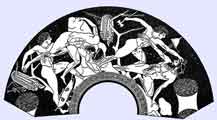
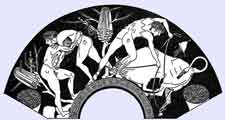
Theseus against Sinis, Sciron, Procrustes and the Marathonian bull, Panaitios painter
Theseus is according of Pausanias the inventor of scientific wrestling.
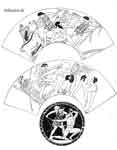
Medea and the Marathonian Bull
When Theseus arrived at Athens, he did not reveal his true identity immediately. He was welcomed by Aegeas, who was suspicious of the stranger. Aegeus's wife, Medea, tried to arrange to have Theseus killed by asking him to capture the Marathonian Bull.
On the way to Marathon, Theseus took shelter from a storm in the hut of an ancient woman named Hecale. She swore to make a sacrifice to Zeus if Theseus was successful in capturing the bull. Theseus did capture the bull, but when he returned to Hecale's hut, she was dead. Theseus subsequently built a deme in her honor.
When Theseus returned victoriously to Athens, Medea tried to poison him but at the last second, Aegeas recognized the sandals, shield, and sword and knocked the poisoned wine glass from Theseus's hand, and father and son were reunited.
Ariadne and the Minotaur

Theseus with a spool of thread from Ariadne, ancient Sculpture
In those days, Athens was required to pay a horrible tax to Crete, the controlling power in the region: Each year, seven young men and seven young women were to be sent to Crete as sacrifices to the Minotaur, a monster in the Labyrinth constructed by Daedalus. Theseus, determined to end this horror, volunteered to be one of the sacrifices, and the fourteen chosen sailed off to Crete on a ship with black sails, for mourning.
Soon after the Athenians arrived in Crete, King Minos raped one of the young women. Theseus protested and boasted of his parentage, as a son of Poseidon. Minos demanded he prove his claim by bringing up a golden ring he threw into the ocean, and in this Theseus was more than successful in that he not only recovered the ring, but also found a lost crown of a previous king as well.
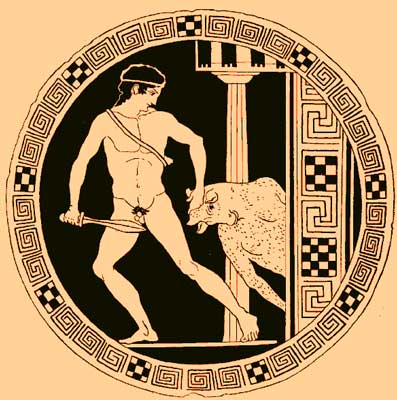
Painting , Kodros Painter? from red-figure kylix showing deeds of Theseus; Attic, 440-430 BC
British Museum, London, United Kingdom
Said to be from Vulci.
Accession number GR 1850.3-2.3 (Cat. Vases E84)
Location Main floor, room 19: Greece: Athens
King Minos's daughter, Ariadne, was engaged to Dionysus. However, she fell in love with Theseus and gave him a magic sword with which to kill the Minotaur, and a spool of thread. Theseus unwound the thread as he wandered through the Labyrinth searching for the Minotaur, so that he could find his way out of the maze again. In some versions, Theseus found and killed the monster while it slept, but later versions have him taking on the creature in battle. After killing the Minotaur with the magic sword, Theseus married and fled to Crete with Ariadne, but then abandoned her, at Athena's request, on the island of Dia, or possibly Naxos.
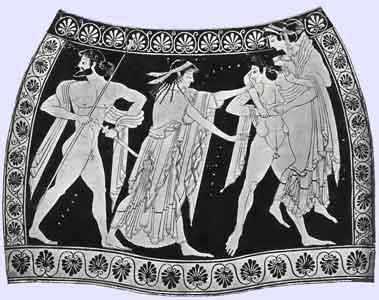
Corone tries to free Helen of Sparta (the names interchanged) carried by Theseus on the left side Pirithous, Euthymides 2309
The return to Athens
Sailing back to Athens, Theseus forgot to change the black sails for white ones, as he had promised his father he would do if he survived. His father, watching from the cliffs at Sounion Head, jumped to his death in despair over his son's presumed demise. When he finally reached Athens, Theseus had to put a stop to Pallas, who was organizing a rebellion to take the city away from him. He was successful, killed Pallas, and became king of Athens.
Plutarch reported that Theseus's ship had been preserved into historical times by gradually replacing all the planks, and that philosophers debated whether it was still the original ship. This question is still known as the "ship of Theseus".
Hippolyte
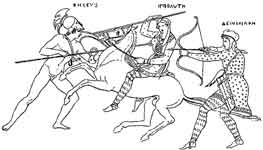
Theseus and the Amazons Hippolyte and Deinomache (Vase painting)

Theseus assists Heracles in his ninth labour - obtaining the girdle of Hippolyte, queen of the Amazons. After succeeding in the task, Theseus kidnaps Hippolyte's sister, Antiope, causing the Amazons to attack Athens to rescue her.
In many versions Theseus marries either Antiope or Hippolyte, having a son Hippolytus. Theseus eventually marries Phaedra, having left his wife, or his wife having died after childbirth. In the version where Theseus is married to, and leaves, Hippolyte, Hippolyte tries to exact revenge by bringing the Amazons into Theseus and Phaedra's wedding to kill everyone, though this fails as she is killed by, in some versions Theseus' men, in others Penthesilea, another Amazon.
Pirithous
Theseus's best friend was Pirithous, Prince of the Lapiths. Pirithous had heard stories of Theseus's courage and strength in battle but wanted proof, so he rustled Theseus's herd of cattle and drove it from Marathon, and Theseus set out in pursuit. Pirithous took up his arms and the pair met to do battle, but were impressed with each other they took an oath of friendship and joined the hunt for the Calydonian Boar. Later, Pirithous was preparing to marry Hippodamia. The centaurs were guests at the wedding feast, but got drunk and tried to abduct the women, including Hippodamia. The Lapiths won the ensuing battle.
Theseus and Pirithous meet Hades
Theseus and Pirithous pledged themselves to marry daughters of Zeus. Theseus chose Helen and together they kidnapped her, intending to keep her until she was old enough to marry. Pirithous chose Persephone. They left Helen with Theseus's mother, Aethra, and travelled to the underworld, domain of Persephone and her husband, Hades. Hades pretended to offer them hospitality and laid out a feast, but as soon as the two visitors sat down, snakes coiled around their feet and held them fast. Or, in some versions, the stone itself grew and attached itself to their thighs.
Heracles freed Theseus but the earth shook when he attempted to liberate Pirithous, and Pirithous had to remain in Hades for eternity. When Theseus returned to Athens, the Dioscuri had taken Helen and Aethra back to Sparta. When Heracles had pulled Theseus from the chair where he was trapped, some of his thigh stuck to it; this explains the supposedly lean thighs of Athenians.
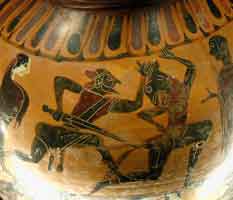
Phaedra and Hippolytus
Phaedra fell in love with Hippolytus, Theseus's son by Hippolyte. According to some versions of the story, Hippolytus had scorned Aphrodite to become a devotee of Artemis, so Aphrodite made Phaedra fall in love with him as punishment. He rejected her. Alternatively, Phaedra's nurse told Hippolytus of her mistress's love and he swore he would not reveal the nurse as his source of information -- even after Phaedra killed herself and blamed it on his seduction of her in her suicide note. In revenge, Phaedra wrote Theseus a letter claiming that Hippolytus had raped her. She then killed herself. Theseus believed her and, using one of the three curses he had received from Poseidon, Hippolytus's horses were frightened by a sea monster and dragged their rider to his death. In other versions, after telling Theseus that Hippolytus had raped her, he killed his son himself and Phaedra committed suicide out of guilt, for she had not intended for Hippolytus to die. Artemis later told Theseus the truth. In yet another version, Phaedra simply told Theseus this and did not kill herself; Dionysus sent a wild bull which terrified Hippolytus's horses.
A cult grew up around Hippolytus, associated with the cult of Aphrodite. Girls who were about to be married offered locks of their hair to him. The cult believed that Asclepius had resurrected Hippolytus and that he lived in a sacred forest near Aricia in Latium.
Theseus and the founding myth of Athens
More broadly, Theseus is the founding hero of Athens, as Solon is Athens' primary political figure of legend. He was responsible for the synoikismos ("dwelling together")—the political unification of Attica, represented in his journey of labours—under Athens. Because he was the unifying king, Theseus built and occupied a palace on the fortress of the Acropolis that may have been similar to the palace excavated in Mycenae. Pausanias reports that after the synoikismos, Theseus established a cult of Aphrodite Pandemos ("Aphrodite of all the People") and Peitho on the southern slope of the Akropolis.
Other stories and his death
According to some sources, Theseus also was one of the Argonauts though Apollonius of Rhodes states in the Argonautica that Theseus was still in the underworld at this time. With Phaedra, Theseus fathered Acamas, who was one of those who hid in the Trojan Horse during the Trojan War. Theseus welcomed the wandering Oedipus and helped Adrastus to bury the Seven Against Thebes. Lycodemes of the island of Scyrus threw Theseus off a cliff after he had lost popularity in Athens. In 475, in response to an oracle, Cimon of Athens, having conquered Skyros for the Athenians, identified as the remains of Theseus "a coffin of a great corpse with a bronze spear-head by its side and a sword" (Plutarch, Life of Cimon, quoted Burkert 1985, p. 206)
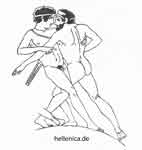
Theseus and Cercyon
Books
Mary Renault's The King Must Die (1958) is a dramatic retelling of the Theseus legend through the return from Crete to Athens. While fictional, is generally faithful to the spirit and flavor of the best-known variations of the original story. The sequel is The Bull from the Sea (1962), about the hero's later career.

Theseus Slaying the Minotaur, Antoine-Louis Barye, 1841-46 , bronze, 47 cm Musée du Louvre, Paris [Source]

Theseus defeats the Centaur, Canova
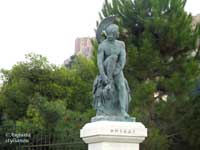
References
- Plutarch, Theseus
- Apollodorus
- Greek Religion, Walter Burkert
- Ruck, Carl A.P. and Danny Staples, The World of Classical Myth, ch. IX "Theseus: making the new Athens 1994, pp. 203-222.
Aegeus King of Athens
Preceded by:
Succeeded by: Menestheus
Nikos Kazantzakis , At the Palaces Of Knossos ,Ohio University Press , 0821408801
Greek Mythology
See also : Greek Mythology. Paintings, Drawings
Retrieved from "http://en.wikipedia.org/"
All text is available under the terms of the GNU Free Documentation License
| Ancient Greece
Science, Technology , Medicine , Warfare, , Biographies , Life , Cities/Places/Maps , Arts , Literature , Philosophy ,Olympics, Mythology , History , Images Medieval Greece / Byzantine Empire Science, Technology, Arts, , Warfare , Literature, Biographies, Icons, History Modern Greece Cities, Islands, Regions, Fauna/Flora ,Biographies , History , Warfare, Science/Technology, Literature, Music , Arts , Film/Actors , Sport , Fashion --- |

